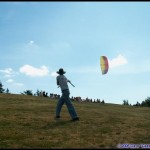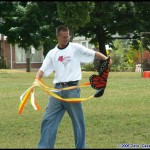Where to start? Well, I guess my age is where I begin. I’ve been a competitor and “hard core” flier for years, but hadn’t really gotten involved in the community aspects until I turned 30 in 2005… Whether it’s maturity (go ahead and laugh – it’s fine) or just having more patience, or just plain curiosity on what else I could involve myself in while still being a part of kiting, but workshops have come up.
Early last year, I got into a discussion about kite workshops with Kay Beusing at the World Kite Museum (WKM), who has seen and organized far more workshops than anyone else I know… During this discussion, she suggested that I run a sport kite workshop for the WKM, covering the basics on up to trick flying.
Sure enough, come April of this year… I’m standing on the beach in Long Beach (WA) with 13 students, figuring my way through my very first workshop with participants from both Oregon and Washington.
I think the most interesting aspect of doing my first workshop was articulating how I actually do the various movements, tricks and such… I mean, for years, I’ve just been doing it. Now it was all about being able to explain the motions generated by all that muscle memory! Needless to say, it gave me a better understanding of flying, and I think it offered up a more human view, with the students being able to see me working through each item.
The way I went about teaching dual line stuff?
The very basics…
- How to assemble your kite
- Check the fittings, etc
- Unrolling/rolling lines
- How to launch, and keep the wind in your sail
- Basic left/right contols
Well, you get the idea… Really starting from the roots of where a beginner is, trying to simplify the little things and take as much of the frustration out as possible.
After this, I went into the next level…
- Corner turns (push/pull/combo turns)
- Landing on the edge of the window
- Spin landings
- Relaunches (Ground flip, sleeping beauty, leading edge)
Now, at my first workshop in April of this year I’d demonstrate each item and then take volunteers to try it out on the kite I’d brought for them to learn on… As each person took a turn, I’d coach them, make corrections, and after 3-4 attempts (usually successful), we’d move on to the next volunteer, or on to the next item.
An interesting note… Nearly all of the 13 students in my April workshop tried the hands on portion, while only 2-3 out of the 18 students in September stepped forward to give it a try… I didn’t find anything very different about the workshop the second time around, so I tend to think it was the group dynamics which obviously change from group to group.
Now that we’d covered all the basic flight and recovery aspects, we moved into stalls, snap stalls, fades and the like… As we got into the fade portion, I switched from full length lines to another approach entirely.
When I attended the NWSKL annual meeting in 2005, their guest speaker was Ari Contzius (an awesome east coast flier) who used a “simulator” technique… He’d set up a kite on 8-10′ lines, handle the kite, and put the student on the handle/strap and of the lines. As he’d explain a trick or maneuver, he’d instruct them through the hand motions and maniuplate the kite to match their inputs… What an awesome idea, and highly effective!
I’ve used this technique with a great deal of success at both of my workshops so far, and will continue to do so… One of the neat aspects, as someone would do their hands on and get the idea, they’d walk over to their own kite (set up outside the teaching area) and work on it while the next student got on the “simulator”, until the next trick came up in the lessons.
Anyway, you get the idea… Why am I talking about this? Well, because I enjoyed it… And because I’ve seen improvements in many of those fliers! Not because it was me really, just because someone took the time to go over everything with them. So, the why is that I think this is a great pastime, and workshops create another excellent cooperative dynamic in your local community.
You can look for more workshops from me in the future, primarily through the WKM (get on their mailing list)… I know that Lam Hoac, Ari Contzius, Carl Robertshaw and a few others do workshops in North America from time to time… If you’re looking to expand your skills, I can’t speak highly enough of spending time with someone at that caliber who can explain the details, in the correct order, with patience.
Now those are just the sport kite workshops… Another area I’ve delved into this year is working with some of the local schools and childrens groups in my hometown, giving presentations and demonstrations of the various kinds of kites!
So far, I’ve worked with an elementary school group and a bunch from day camp… These went a little differently (for obvious reasons), focusing primarily on education. Here are some of the basic areas I’ve focused on so far, although I’m still in the early development of my own presentations:
- Kite safety (#1).
- Types of kites (dual line, quad line, single line).
- Variants (power kites, parafoils, etc).
- How physics relate to kites (simple terms).
- Other applications (weather testing, boats, etc).
- LOTS and LOTS of question and answer time.
So far, my groups have been an average age of 7-12 years of age, generally in groups of 15-20, with 2-3 teachers or counselors along for the ride… The show is mine, and the adults take a seat right alongside the kids, there to assist with crowd control if needed.
Now, up to this point I’d been doing presentation and demonstration… I didn’t have extra kites along with me… And you know what? They wanted to fly… That was the #1 comment I heard afterwards, is “do you have any kites we can fly?”
One observation. In many cases, the venue or location is selected by the group you’re working with, and may not provide the best environment for flying… So far this year, I’ve flown in an outdoor stadium surrounded by trees, one public park and a school… All of them either in a very wooded area, or in the middle of the city, making for some very shaky wind conditions.
But, when you have that one kid put his hand up and say “I know what that is, it’s a stunt kite!” it really makes the whole thing worthwhile, never mind the smiling faces beaming back at you.
Sure, that makes sense… Remember, I’m learning too.
Naturally, I’ve begun gathering a collection of very simple to use single line kites which I will be taking along with me for future workshops like this one… I don’t make kites, never have… Yeah, most kids workshops are about making kites… But, what I’ve found to be the most interesting and rewarding part of these groups by far is watching these young minds work, seeing how the group interacts, doing my part to nudge them into cooperation and sharing, trying to put them in touch with what I feel is so special about kite flying, with pretty fair success.
You put a kite in an elderly person’s hand, and you watch them get lighter… A smile pops out… Their heart rate probably settles down… What is that?
It’s magic, man… Magic.
If you’ve got something to share, and feel it deep down inside… Go ahead. I’ve related these experiences primarily to share what I’ve felt, and some of the mutual benefits that I can see… I know it’s nothing new, but I was moved, and moved to write.
See you on the field,
John Barresi


















